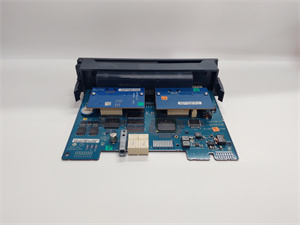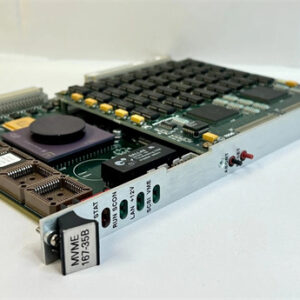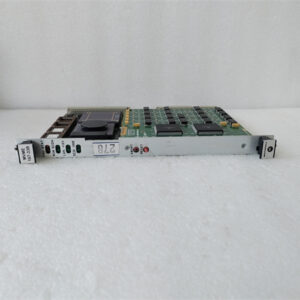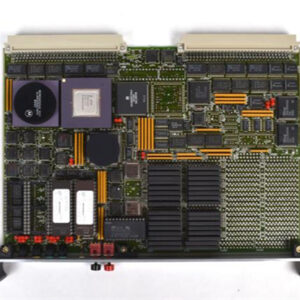Description
Motorola MVIP301 Product Description
Detailed parameter table
| Parameter name | Parameter value |
|---|---|
| Product model | MVIP301 |
| Manufacturer | Motorola |
| Product category | Industrial control module, specifically an IP – Serial module |
| Voltage range | 24 V DC |
| Current rating | 5 A |
| Operating temperature | – 40 °C to + 85 °C |
| Protection class | IP65 (some sources suggest IP67, but IP65 is also common for industrial – grade protection against dust and water jets) |
| Communication interfaces | Ethernet, RS – 485 |
| Input channels | 8 |
| Output channels | 4 |
| Frequency range | 50 / 60 Hz |
| Dimensions | 150 mm x 100mm x 40mm |
| Weight | 1.2 kg |
| Certifications | CE, UL, RoHS |
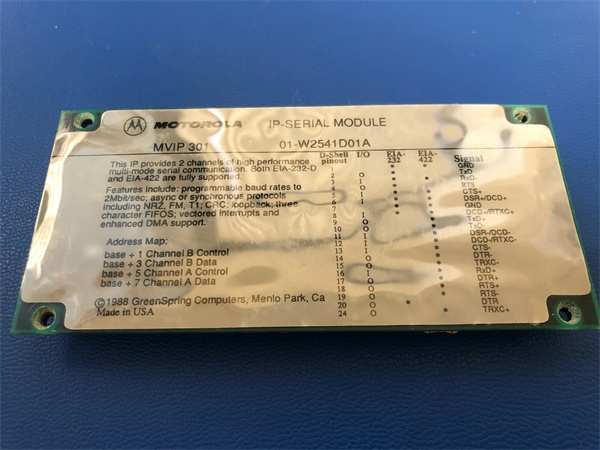
MVIP301
Product introduction
The Motorola MVIP301 is a state – of – the – art industrial control module crafted by Motorola, a venerable name in the industrial technology domain. Engineered for advanced automation and intricate process control applications, this module has carved a niche for itself in various industrial landscapes.
As an IP – Serial module, the MVIP301 serves as a crucial bridge between different components in an industrial system. It enables seamless data transfer and communication, which is fundamental for efficient operation. With its 8 input channels, it can effectively gather data from multiple sensors, switches, or other input devices in real – time. The 4 output channels, on the other hand, are responsible for transmitting control signals to actuators, motors, or other output – based equipment. This bidirectional data handling capability makes it an essential part of any industrial control setup, whether it’s in a manufacturing plant, an energy management facility, or a large – scale industrial complex. The MVIP301‘s design is centered around providing reliable performance and versatile functionality, ensuring that it can adapt to diverse industrial requirements.
Core advantages and technical highlights
Robust and reliable operation
The MVIP301 is built to last in the harshest of industrial environments. With an operating temperature range spanning from – 40 °C to + 85 °C, it can function flawlessly in extreme cold or hot conditions, such as in outdoor industrial facilities in polar regions or in factories with high – temperature processes. Its IP65 (or potentially IP67) protection class shields it from dust and water jets (or even temporary submersion in the case of IP67), safeguarding its internal components from damage. This robust construction ensures minimal downtime and long – term, stable operation, which is critical for industrial processes where continuous productivity is essential.
Versatile communication capabilities
Featuring both Ethernet and RS – 485 communication interfaces, the MVIP301 offers unparalleled flexibility in connecting to different devices and systems. The Ethernet interface allows for high – speed data transfer, making it suitable for applications that require real – time monitoring and control over a network. For example, it can communicate with other control modules, human – machine interfaces (HMIs), or even cloud – based platforms for remote management. The RS – 485 interface, on the other hand, is ideal for connecting to legacy industrial devices, sensors, and actuators that use this standard for communication. This versatility enables the MVIP301 to be integrated into both modern and older – generation industrial setups, without the need for extensive rewiring or system overhauls.
Compliance with international standards
Certifications like CE, UL, and RoHS are a testament to the MVIP301‘s quality and safety. CE compliance indicates that the module meets European health, safety, and environmental protection standards. UL certification, recognized globally, ensures that the product has undergone rigorous safety testing. RoHS compliance means that the module is free from hazardous substances, making it environmentally friendly. These certifications not only guarantee the quality of the MVIP301 but also give users the confidence that it can be used in various regions and industries without concerns about regulatory non – compliance.
Typical application scenarios
Manufacturing industry
In manufacturing plants, the Motorola MVIP301 plays a pivotal role. It can be used to control and monitor automated production lines. For instance, it can receive data from sensors that detect the position, speed, and quality of products as they move along conveyor belts. Based on this real – time data, the MVIP301 can send control signals to robotic arms, motors, and other actuators to adjust the production process. In a car manufacturing plant, it can ensure that each component is accurately assembled, reducing errors and increasing production efficiency. Its ability to handle multiple input and output channels makes it suitable for managing complex manufacturing processes with numerous interconnected devices.
Energy management
In power generation and distribution facilities, the MVIP301 is an invaluable asset. It can interface with sensors that monitor electrical parameters such as voltage, current, and power factor. By analyzing this data, it can control the operation of generators, transformers, and other power – related equipment. For example, in a wind farm, the MVIP301 can adjust the pitch of wind turbine blades based on wind speed and direction data received from sensors. In a power grid substation, it can monitor and control the switching of circuit breakers to ensure stable power supply. Its wide operating temperature range and robust construction make it suitable for use in outdoor power facilities, where environmental conditions can be harsh.
Industrial automation systems integration
When integrating different components into an industrial automation system, the MVIP301 serves as a key enabler. It can connect new, advanced industrial devices with existing legacy systems. For example, in a factory that is upgrading its automation system, the MVIP301 can use its Ethernet interface to communicate with modern programmable logic controllers (PLCs) and HMIs, while simultaneously using its RS – 485 interface to connect to older sensors and actuators. This seamless integration allows for a phased upgrade of the automation system, reducing costs and minimizing disruptions to production.
Related model recommendations
MVIP302
The MVIP302 is an octal series interface module. It has a similar form factor and is part of the same product family as the MVIP301. While the MVIP301 focuses on IP – Serial functionality with a specific number of input and output channels, the MVIP302 may be more suitable for applications that require a higher number of serial – based connections. For example, in a large – scale industrial monitoring system with numerous serial – connected sensors, the MVIP302‘s octal interface can handle more connections without the need for additional expansion modules.
MVIP303
The MVIP303 is also an octal interface module, but it is an octal 422 interface. It is designed for applications that specifically require the 422 communication standard. If an industrial setup has devices that communicate using the RS – 422 protocol, the MVIP303 would be a better choice than the MVIP301. It offers enhanced compatibility and performance in such setups, especially in scenarios where high – speed, reliable serial communication over longer distances is required, such as in some industrial control networks spread over a large factory floor.
MVME – 147A
The MVME – 147A is an embedded single – board computer module. Although it has a different form and function compared to the MVIP301, they can be used in complementary ways in an industrial system. The MVME – 147A provides processing power, while the MVIP301 can be used for communication and interfacing with external devices. In a complex industrial control system, the MVME – 147A can run control algorithms and software, and the MVIP301 can handle the input and output data transfer between the system and the outside world, ensuring seamless operation.
FLN2414B
The FLN2414B is a CPU module. It can work in tandem with the MVIP301 in an industrial setup. The FLN2414B can perform computational tasks, and the MVIP301 can handle the communication and control functions. For example, in a data – intensive industrial application where real – time data processing and control are required, the FLN2414B can process the data received through the MVIP301 from various sensors, and then the MVIP301 can send out the control signals based on the processed data.
MC68360RC25C
The MC68360RC25C is a CPU. It can be considered as an alternative or supplementary component depending on the application. In some cases, if the processing requirements of the system where the MVIP301 is used change, the MC68360RC25C can be integrated to provide different levels of processing power. It may offer different performance characteristics, such as clock speed and memory management capabilities, which can be optimized for specific industrial applications where the MVIP301 is handling the input and output communication tasks.
Installation, commissioning and maintenance instructions
Installation preparation
Before installing the Motorola MVIP301, ensure that the installation environment is clean and free from excessive dust, as the module’s IP65 protection, while robust, is not a substitute for a clean environment. The ambient temperature should be within the specified – 40 °C to + 85 °C range. Use appropriate anti – static tools and wrist straps to handle the module, as static electricity can damage its sensitive components. When connecting to other devices, double – check the wiring diagrams for the Ethernet and RS – 485 connections. Ensure that the power supply providing 24 V DC is stable and has a capacity to handle the 5 A current draw of the MVIP301. Mount the module in a secure location, taking into account its dimensions (150 mm x 100mm x 40mm) and weight (1.2 kg) to prevent any accidental dislodgment.
Maintenance suggestions
Regularly inspect the MVIP301 for any signs of physical damage, such as cracks in the casing or loose connectors. Use a dry, soft brush to clean any accumulated dust, especially around the ventilation areas if applicable. Periodically test the communication interfaces by sending test signals through the Ethernet and RS – 485 connections. If any issues arise, start by checking the power supply voltage and current, as well as the integrity of the communication cables. In case of a malfunction, refer to the Motorola technical documentation for troubleshooting steps. When replacing components, always use genuine Motorola parts to maintain the module’s reliability and compatibility. Keep a record of all maintenance activities, including the date, actions taken, and any issues resolved, for future reference.
Service and guarantee commitment
Motorola stands firmly behind the Motorola MVIP301. The module undergoes strict quality control procedures during manufacturing to meet the high standards denoted by its CE, UL, and RoHS certifications. Motorola offers a comprehensive warranty period, covering any manufacturing defects that may occur. In the event of issues within the warranty period, Motorola’s global technical support team is readily available. They can provide detailed guidance on installation, efficient troubleshooting, and maintenance. Motorola also invests in continuous research and development, and may release software updates (if applicable) to enhance the functionality and compatibility of the MVIP301. The company provides extensive documentation, including user manuals and technical guides, to assist users in maximizing the potential of the module. This commitment reflects Motorola’s confidence in the product’s quality and its dedication to customer satisfaction in the industrial control field.
We've got you covered
We give you access to a global supply of automation parts at your fingertips, ensuring that manufacturers around the world can avoid unnecessary downtime and continue to do what they do best – making our world possible.
Full 12-month warranty on all components
Dedicated after-sales support
Same-day dispatch on 1000s of parts
All units are fully tested
Continue Searching
We're here when you need us
What happens next?
- 1. Email confirmation
You will get an email confirming that we have received your enquiry. - 2. Dedicated Account Manager
One of our team will be in touch to confirm your part(s) specification and condition. - 3. Your quote
You will receive a comprehensive quote tailored to your specific needs.
 Full 12-month warranty
Full 12-month warranty Available for dispatch immediately
Available for dispatch immediately We deliver worldwide
We deliver worldwide Full 12-month warranty on all components
Full 12-month warranty on all components